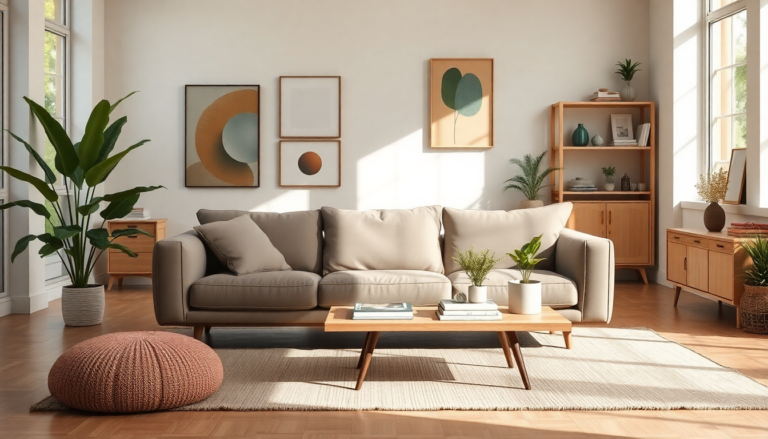Argomenti trattati
In the ever-evolving world of interior design, Gen Z is not just a demographic; they’re a powerful force driving contemporary trends. Have you noticed how their unique style seamlessly blends nostalgia with innovation? They’re drawn to pieces that serve a purpose but also tell a story. One standout trend that’s capturing attention is the rise of low-profile seating. This isn’t just about furniture; it reflects a broader shift towards creating inviting spaces that foster lounging and connection.
Emerging Trends in Gen Z Design
What’s shaping the design preferences of Gen Z today? It’s a fascinating mix of comfort and playful aesthetics. Low-slung, lounge-style seating is gaining traction, reminiscent of cozy ’70s lounges. These pieces often feature plush, inviting designs—think ribbed or flat surfaces with rounded, bubble-like silhouettes that radiate warmth and intimacy.
In my experience, the best designs resonate on both an emotional and functional level, and low-profile seating nails this balance beautifully. The soft, enveloping shapes not only enhance comfort but also encourage social interaction. They turn living areas into havens for relaxation and connection, perfectly echoing the values of a generation that prioritizes well-being and quality time with loved ones.
Data Analysis and Performance Insights
As we dive deeper into this trend, the data tells a compelling story. Analytics from social media platforms reveal a notable increase in posts showcasing curved sofas and low-profile chairs, especially among Gen Z influencers. The engagement metrics—likes and shares—indicate that these pieces resonate strongly, suggesting they’re not just fleeting fads but essential elements of Gen Z’s design narrative.
Brands that have adapted their offerings to align with this trend are reaping impressive returns on ad spend (ROAS). Take, for instance, a furniture retailer that launched a campaign focused on low-profile seating; they reported a 30% increase in customer engagement and a 25% rise in sales within the first quarter of the campaign. These metrics highlight how catering to Gen Z’s preferences can yield significant rewards.
Case Study: The Togo Sofa’s Rise to Prominence
One of the most iconic examples of this trend is Michel Ducaroy’s Togo sofa, designed in 1973 for Ligne Roset. Its popularity has skyrocketed in recent years, particularly on social media platforms like TikTok and Instagram, where it’s gained favor among Gen Z celebrities and influencers. The Togo’s unique design, inspired by a half-used tube of toothpaste, features an all-foam structure that appears inviting while providing exceptional support.
Interestingly, the Togo has become a symbol of individuality, perfectly reflecting Gen Z’s desire for personal expression in their home design. Interior designer Audrey Scheck notes that this generation loves infusing personality into their spaces, opting for whimsical shapes and vibrant colors that showcase their identities. The Togo embodies this ethos, combining a playful silhouette with luxurious materials like brushed velvet and distressed leather.
Practical Implementation Tactics
Thinking about incorporating low-profile seating into your home? Start with a statement piece like the Togo sofa or its many inspiring lookalikes available at various price points. When choosing furniture, prioritize designs that not only complement your existing decor but also invite comfort and relaxation. Consider creating a cozy nook with extra cushions and throws to enhance the appeal of low-slung seating, encouraging a laid-back atmosphere perfect for lounging.
Additionally, think about your space’s layout. Arranging furniture to foster conversation and connection can facilitate social interactions, making your home feel welcoming. Low-profile seating works particularly well in smaller spaces, where it can create an open and airy vibe. As you embrace this trend, remember: the key is to balance style with comfort, ensuring your home reflects both your aesthetic preferences and lifestyle needs.
Key Performance Indicators to Monitor
As you explore integrating low-profile furniture into your design strategy, keep a close eye on several key performance indicators (KPIs). Customer engagement metrics—like social media interactions, website traffic, and conversion rates—will help you assess the effectiveness of your design choices. Don’t forget to monitor customer feedback and reviews to gain insights into how these pieces resonate with your audience.
By aligning your home design with Gen Z’s preferences, you not only elevate your living space but also tap into a broader cultural movement that values comfort, creativity, and individuality. This trend is about more than aesthetics; it reflects a deeper understanding of how design can shape our experiences and connections in everyday life. So, are you ready to embrace this exciting shift in interior design?

